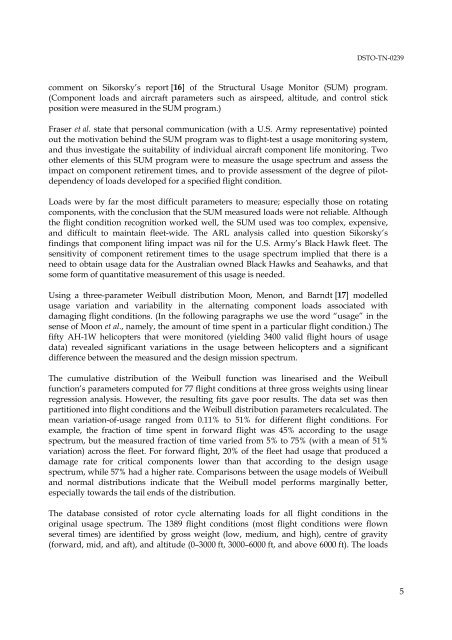Estimation of Structural Component Loads in Helicopters: A Review ...
Estimation of Structural Component Loads in Helicopters: A Review ...
Estimation of Structural Component Loads in Helicopters: A Review ...
You also want an ePaper? Increase the reach of your titles
YUMPU automatically turns print PDFs into web optimized ePapers that Google loves.
DSTO-TN-0239comment on Sikorsky’s report [16] <strong>of</strong> the <strong>Structural</strong> Usage Monitor (SUM) program.(<strong>Component</strong> loads and aircraft parameters such as airspeed, altitude, and control stickposition were measured <strong>in</strong> the SUM program.)Fraser et al. state that personal communication (with a U.S. Army representative) po<strong>in</strong>tedout the motivation beh<strong>in</strong>d the SUM program was to flight-test a usage monitor<strong>in</strong>g system,and thus <strong>in</strong>vestigate the suitability <strong>of</strong> <strong>in</strong>dividual aircraft component life monitor<strong>in</strong>g. Twoother elements <strong>of</strong> this SUM program were to measure the usage spectrum and assess theimpact on component retirement times, and to provide assessment <strong>of</strong> the degree <strong>of</strong> pilotdependency<strong>of</strong> loads developed for a specified flight condition.<strong>Loads</strong> were by far the most difficult parameters to measure; especially those on rotat<strong>in</strong>gcomponents, with the conclusion that the SUM measured loads were not reliable. Althoughthe flight condition recognition worked well, the SUM used was too complex, expensive,and difficult to ma<strong>in</strong>ta<strong>in</strong> fleet-wide. The ARL analysis called <strong>in</strong>to question Sikorsky’sf<strong>in</strong>d<strong>in</strong>gs that component lif<strong>in</strong>g impact was nil for the U.S. Army’s Black Hawk fleet. Thesensitivity <strong>of</strong> component retirement times to the usage spectrum implied that there is aneed to obta<strong>in</strong> usage data for the Australian owned Black Hawks and Seahawks, and thatsome form <strong>of</strong> quantitative measurement <strong>of</strong> this usage is needed.Us<strong>in</strong>g a three-parameter Weibull distribution Moon, Menon, and Barndt [17] modelledusage variation and variability <strong>in</strong> the alternat<strong>in</strong>g component loads associated withdamag<strong>in</strong>g flight conditions. (In the follow<strong>in</strong>g paragraphs we use the word “usage” <strong>in</strong> thesense <strong>of</strong> Moon et al., namely, the amount <strong>of</strong> time spent <strong>in</strong> a particular flight condition.) Thefifty AH-1W helicopters that were monitored (yield<strong>in</strong>g 3400 valid flight hours <strong>of</strong> usagedata) revealed significant variations <strong>in</strong> the usage between helicopters and a significantdifference between the measured and the design mission spectrum.The cumulative distribution <strong>of</strong> the Weibull function was l<strong>in</strong>earised and the Weibullfunction’s parameters computed for 77 flight conditions at three gross weights us<strong>in</strong>g l<strong>in</strong>earregression analysis. However, the result<strong>in</strong>g fits gave poor results. The data set was thenpartitioned <strong>in</strong>to flight conditions and the Weibull distribution parameters recalculated. Themean variation-<strong>of</strong>-usage ranged from 0.11% to 51% for different flight conditions. Forexample, the fraction <strong>of</strong> time spent <strong>in</strong> forward flight was 45% accord<strong>in</strong>g to the usagespectrum, but the measured fraction <strong>of</strong> time varied from 5% to 75% (with a mean <strong>of</strong> 51%variation) across the fleet. For forward flight, 20% <strong>of</strong> the fleet had usage that produced adamage rate for critical components lower than that accord<strong>in</strong>g to the design usagespectrum, while 57% had a higher rate. Comparisons between the usage models <strong>of</strong> Weibulland normal distributions <strong>in</strong>dicate that the Weibull model performs marg<strong>in</strong>ally better,especially towards the tail ends <strong>of</strong> the distribution.The database consisted <strong>of</strong> rotor cycle alternat<strong>in</strong>g loads for all flight conditions <strong>in</strong> theorig<strong>in</strong>al usage spectrum. The 1389 flight conditions (most flight conditions were flownseveral times) are identified by gross weight (low, medium, and high), centre <strong>of</strong> gravity(forward, mid, and aft), and altitude (0–3000 ft, 3000–6000 ft, and above 6000 ft). The loads5
















